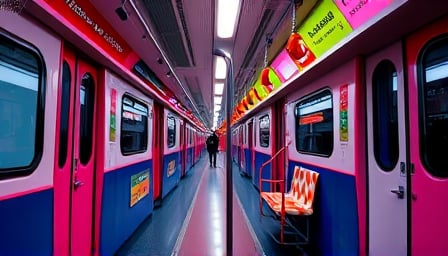Corporate News – Market and Strategic Analysis
Overview of MTR Corp Ltd.
MTR Corp Ltd., Hong Kong’s flagship public‑transport operator, has experienced pronounced volatility in its share price over the past eighteen months. After reaching a 52‑week peak of HK$30.65 in October 2024, the stock fell to a low of HK$23.80 in April 2025, before rebounding to roughly HK$26.34 as of mid‑2025. The recent recovery reflects a combination of broader market stabilization and the company’s ongoing efforts to diversify its revenue base.
Financial Performance and Pandemic‑Related Headwinds
The COVID‑19 pandemic imposed severe demand shocks on the public‑transport sector, leading to lower ridership and reduced farebox revenue. MTR Corp’s earnings reports during 2020‑2021 show a contraction in operating income, offset in part by cost‑control initiatives and government subsidies. While the company’s core rail operations remain a dependable income generator, the pandemic underscored the need for revenue resilience in an industry exposed to macro‑economic cycles and public‑health disruptions.
Diversification Strategy
To mitigate overreliance on passenger transport, MTR Corp has pursued a multi‑pronged diversification strategy:
| Segment | Description | Recent Activity |
|---|---|---|
| Property Development & Management | Leveraging rail‑adjacent land holdings to develop commercial and residential projects. | Completed several high‑profile mixed‑use developments near major stations; ongoing expansion of the “Transit‑Oriented Development” portfolio. |
| Advertising & Retail | Selling advertising space on trains, stations, and digital platforms; operating retail outlets within stations. | Introduced dynamic digital signage and partnered with global brands for in‑station retail concepts. |
| Telecommunications Facilities | Installing and managing telecom infrastructure along the rail network (e.g., fiber optic cables, 5G base stations). | Secured contracts with major telecom operators; integrated 5G support across the network to enhance passenger connectivity and data services. |
These initiatives not only broaden revenue streams but also deepen the company’s integration with urban development and technology ecosystems, positioning it favorably amid the global shift towards smart‑city infrastructure.
Government Investment and Sectoral Growth
Hong Kong Infrastructure Funding
The Hong Kong government’s recent allocation of capital to the Jurong Region Line and the Cross Island Line exemplifies a sustained commitment to expanding rail capacity. The projected increase in network coverage is expected to:
- Raise overall ridership by 5‑7 % over the next five years.
- Stimulate economic activity in under‑served districts.
- Create ancillary revenue opportunities for operators through expanded advertising and retail footprints.
These investments signal confidence in the rail sector’s long‑term viability, potentially supporting MTR Corp’s property and telecom ventures as well.
Mainland China Rail Expansion
Parallel to Hong Kong’s initiatives, the Chinese government’s announcement of a new investment in Tianjin Metro Line 7 highlights a broader regional push to upgrade and expand urban rail. The Tianjin project will:
- Extend metro coverage to rapidly developing suburban zones.
- Support the integration of multimodal transport hubs.
- Generate construction and operational employment, contributing to local economic growth.
The cross‑border investment environment creates opportunities for collaborative projects, such as joint property developments or shared telecom infrastructure, thereby fostering inter‑regional synergies.
Comparative Industry Dynamics
Intercontrol Technology – A Signal Systems Success Story
Intercontrol Technology’s recent stock surge reflects investor optimism about the upgrade phase of railway infrastructure. Key drivers include:
- Technological Modernization: Adoption of AI‑driven signal control and predictive maintenance systems.
- Infrastructure Renewal: Government‑backed refurbishment of legacy lines.
- Regulatory Support: Stricter safety standards increasing demand for advanced signaling solutions.
The company’s trajectory underscores a sectoral shift toward high‑value, tech‑enabled services, suggesting that operators like MTR Corp may benefit from partnerships or acquisitions in this space to accelerate digital transformation.
Competitive Pressures and Alternative Modes
Despite robust government support, the public‑transport sector confronts several challenges:
| Factor | Impact | Mitigation |
|---|---|---|
| Rising Operational Costs | Fuel, maintenance, labor | Cost‑optimization initiatives; automation |
| Competing Transport Modes | Ride‑hailing, micro‑mobility | Integrated mobility platforms; loyalty programs |
| Regulatory Shifts | Environmental standards | Investment in electrification and green technologies |
| Pandemic‑Induced Demand Volatility | Reduced ridership | Flexible pricing; diversification of revenue streams |
Strategic responses involve leveraging technology, enhancing customer experience, and exploring multi‑modal integration to maintain competitive advantage.
Economic Context and Outlook
The public‑transport landscape in Hong Kong and China is poised for sustained growth, driven by:
- Urbanisation trends: Expanding metropolitan populations require efficient mass transit.
- Economic stimulus packages: Infrastructure spending continues to be a key growth lever.
- Technological convergence: Integration of IoT, big data, and AI in transport operations.
However, macro‑economic uncertainties—such as global supply chain disruptions and fluctuating commodity prices—may affect project timelines and capital costs. Companies that can balance fiscal discipline with strategic investment in innovation are likely to emerge as leaders.
Conclusion
MTR Corp Ltd. stands at a pivotal juncture where traditional rail operations, diversification initiatives, and regional infrastructure developments intersect. Its ability to navigate market volatility, capitalize on government investment, and adapt to evolving industry dynamics will determine its long‑term shareholder value. The broader sector’s trajectory—characterised by government‑driven expansion, technological upgrade, and competitive diversification—provides a context in which MTR and its peers must continually refine their strategic focus to sustain growth and resilience.
